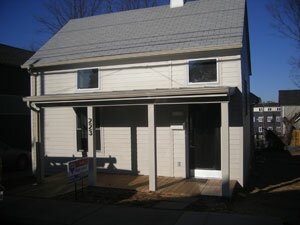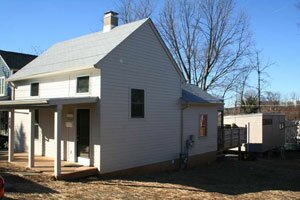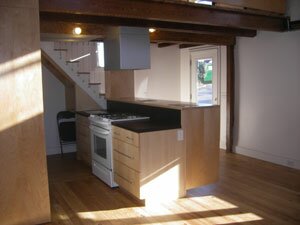REAL ESTATE- ON THE BLOCK- ecoMOD3: A 'seamly' offering off Dice Street

PHOTOS BY ROSALIND WARFIELD-BROWN
ADDRESS: 223 4th Street
NEIGHBORHOOD: Midtown
ASKING: $298,900
ASSESSMENT: construction not assessed (land only $43,500)
YEAR BUILT: 1995
SIZE: 1,236 fin. sq. ft.
LAND: 0.09 acres
CURB APPEAL: 8 out of 10
LISTED BY: Roger Voisinet ReMax Realty Specialists 974-1500 (cell) 981-3357
ecoMod3– the word itself represents the house it describes. The combination of lower-case eco and all-cap MOD embodies the essence of this oldNEW house in three parts on 4th street behind the fire station on Ridge.
A joint endeavor of UVA and the Piedmont Housing Alliance, ecoMod is a multi-year project of "interdisciplinary teams of architecture, engineering, landscape architecture, historic preservation, business, environmental science, planning and economics students" at UVA, according to the agent's website. The point is to design and build a series of modular "green" houses at affordable prices.
This house, as the "3" snuggled up against MOD indicates, is the third in the series: there's one built, sold, and inhabited over on 7-1/2 street off Cherry avenue, and the second is holding its own somewhere on the Mississippi Gulf coast. This third one is a combination of original modest house and contemporary modular addition with a detached studio apartment at the back.
The main (front) section of this property– known to local preservation/history types as the "Smith Reaves house" but known to the UVA worker bees as the "SEAM" house (something about the juncture between in and out, old and new)– is thought to have originally been a one-room slave quarters that morphed to four square rooms over the late 19th century. This part (the traditional house) has been renovated using ecologically sound building practices and sustainable materials.
The front door opens to a stairway leading to an attic/loft that takes up only about two thirds of the room, so the "living room" part of the first level on the left has a roof-high ceiling. The very small kitchen is the original room of the house.
Exposed weathered timbers everywhere attest to the history– and if that's not enough to remind us that we're walking in the past, in the upstairs loft/office, a large beam has been cut away to hold a series of little busy boxes containing artifacts found on the property and in the house as the renovation progressed. While this might not appeal to a Forest Lakes or Cory Farm sensibility, the whimsical objects in the cases will probably warm the heart of anyone else who would seriously consider buying this house.
Also in the original part of the house is one bedroom with the original roof serving as the ceiling, and former exterior walls exposed– it's a close approximation of sleeping outside while actually being inside. A very large bath/laundry with lots of pretty tile and a pocket door is fully handicap accessible, as are all the doors/openings and counter heights in the house, making this an interesting choice for someone with elderly parents– or someone handicapped who wants a modern convenient house for him or herself.
The Thermasteel addition at the rear has a cork floor, large double casement windows, a strange little pop-out window seat that seems to be a hallmark of these houses (there's one in the 7-l/2 street house, too), and a green roof growing with sedum. The house is designed to be "nature neutral," which means the deck is treated with something called Boraid instead of creosote or everyone's favorite, good old poisonous chromated copper arsenate.
It also means that the water is solar-heated by roof-mounted panels, and when heat or AC is necessary, it's powered by individual Mitsubishi heat pumps on the walls of individual rooms– and operated by remote control to eliminate ductwork. Windows are placed to maximize light and limit reliance on electricity.
A courtyard separates this part of the property from an entirely self-contained module at the back. This little gem is designed to be a rental unit or in-law space, but from our point of view it's the primo place to park a futon and stereo system and hunker down.
This completely contemporary part of the house, assembled by the students at a UVA workspace at the Milton airport (who knew?), is the most energy-efficient of the three segments, with on-demand hot water, another sedum roof, and a great deck with cabling to provide a trellis for summer shade plants. The beautiful full tile shower here is another plus, and the kitchen, while of course decidedly minimalist, has a nice window over the sink looking out to the side yard.
The house is subject to income guidelines dictated by PHA: a future buyer (owner must occupy) family of two can't earn more than $76,900, and a family of three or more mustn't list a penny more than $90,000 on the IRS 1040.
One of the most interesting things about the house is the students' emphasis on its "deconstructability." What has architecture come to, when a major selling point for a house is the fact that it can be easily "disassembled"?
What does it say about our world view, our outlook on the future, that our most inventive and creative young people are building things that can disappear in the wink of an eye? What do they know that we don't?


PHOTOS BY ROSALIND WARFIELD-BROWN
Each week, a brave local seller invites the Hook to provide an impartial, warts-and-all look at their real estate listing. E-mail yours today!
#